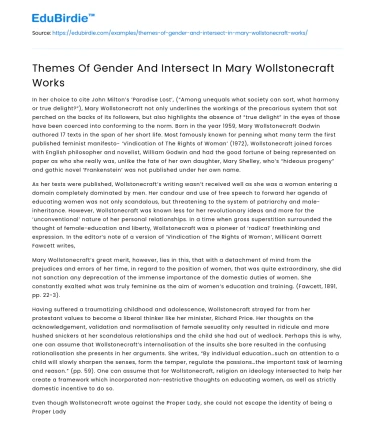In her choice to cite John Milton’s ‘Paradise Lost’, (“Among unequals what society can sort, what harmony or true delight?”), Mary Wollstonecraft not only underlines the workings of the precarious system that sat perched on the backs of its followers, but also highlights the absence of “true delight” in the eyes of those have been coerced into conforming to the norm. Born in the year 1959, Mary Wollstonecraft Godwin authored 17 texts in the span of her short life. Most famously known for penning what many term the first published feminist manifesto- ‘Vindication of The Rights of Woman’ (1972), Wollstonecraft joined forces with English philosopher and novelist, William Godwin and had the good fortune of being represented on paper as who she really was, unlike the fate of her own daughter, Mary Shelley, who’s “hideous progeny” and gothic novel ‘Frankenstein’ was not published under her own name.
As her texts were published, Wollstonecraft’s writing wasn’t received well as she was a woman entering a domain completely dominated by men. Her candour and use of free speech to forward her agenda of educating women was not only scandalous, but threatening to the system of patriarchy and male-inheritance. However, Wollstonecraft was known less for her revolutionary ideas and more for the ‘unconventional’ nature of her personal relationships. In a time when gross superstition surrounded the thought of female-education and liberty, Wollstonecraft was a pioneer of ‘radical’ freethinking and expression. In the editor’s note of a version of ‘Vindication of The Rights of Woman’, Millicent Garrett Fawcett writes,
Save your time!
We can take care of your essay
- Proper editing and formatting
- Free revision, title page, and bibliography
- Flexible prices and money-back guarantee
Mary Wollstonecraft’s great merit, however, lies in this, that with a detachment of mind from the prejudices and errors of her time, in regard to the position of women, that was quite extraordinary, she did not sanction any deprecation of the immense importance of the domestic duties of women. She constantly exalted what was truly feminine as the aim of women’s education and training. (Fawcett, 1891, pp. 22-3).
Having suffered a traumatizing childhood and adolescence, Wollstonecraft strayed far from her protestant values to become a liberal thinker like her minister, Richard Price. Her thoughts on the acknowledgement, validation and normalisation of female sexuality only resulted in ridicule and more hushed snickers at her scandalous relationships and the child she had out of wedlock. Perhaps this is why, one can assume that Wollstonecraft’s internalisation of the insults she bore resulted in the confusing rationalisation she presents in her arguments. She writes, “By individual education…such an attention to a child will slowly sharpen the senses, form the temper, regulate the passions…the important task of learning and reason.” (pp. 59). One can assume that for Wollstonecraft, religion an ideology intersected to help her create a framework which incorporated non-restrictive thoughts on educating women, as well as strictly domestic incentive to do so.
Even though Wollstonecraft wrote against the Proper Lady, she could not escape the identity of being a Proper Lady herself. Wollstonecraft lived in the time of conduct books and literature that was framed by Fordyce’s ‘Sermons to Young Women’ (1767). Conduct and etiquette came packed in the form of magazines like Tatler and Spectator- texts which endorsed chastity and obedience. Wollstonecraft illustrates her rejection of conduct literature and exposes the extent of oppression under the garb of refinement by writing, “Many (men) are the causes that in the present corrupt state of society, contribute to enslave women by cramping their understandings and sharpening their senses…to do everything in an orderly manner, is a most important precept…”(pp. 61).
William Godwin, who Wollstonecraft legally married the year she died, 1697, wrote many texts and pamphlets on property laws and their restrictive and exclusive policies. As a radically liberal couple, both Wollstonecraft and Godwin believed in the equal distribution of property amongst all heirs- including women. In her text termed, ‘Thoughts on The Education of Daughters’ (1787), Wollstonecraft even highlights the capitalist motive behind male-inheritance. Both Godwin and Wollstonecraft criticized the system bitterly about its centuries-old practice of keeping property, agency, resources and thus, independence, out of women’s hands. In ‘The Proper Lady and the Woman Writer’, Mary Poovey writes,
…Eighteenth century witnessed the political and economic triumph of the English middle classes…The duties a woman fulfilled in the home directly supported capitalist values…the sympathetic, non-judgmental affection the ideal wife offered her husband helped offset the frustrations and strains a man suffered in his workplace and thus both contributed to the rewards associated with work and helped a man renew his energies for another day’s labours. (1984, pp. 10).
Mary Wollstonecraft died 11 days after giving birth to her daughter by Godwin. While her life was dedicated to resisting superstition and fighting for equality, her own daughter’s was plagued with superstition surrounding the womb and her inability to birth a healthy baby. Wollstonecraft fought the convention through her texts, but fell prey to it during her last year, when she married Godwin so as to remove the tag of illegitimacy from her unborn child’s name and thus allowed for Mary Shelley’s name to be joined with her father’s and not her mother’s. Wollstonecraft wrote compelling arguments in her texts and yet she had to buckle to the system to prevent herself and her family from being social pariahs.
Battling superstition and stereotype of being a woman writer of the 18th century, Wollstonecraft meets the writing norm halfway by penning the moral standard and norm she was expected to uphold into her texts. For example, she writes, “Teach them (women), in common with man, to submit to necessity, instead of giving, to render them more pleasing, a sex to morals.” (pp. 76). Another approach to reading her texts is also considering the possibility that to appease the orthodox Christian community and the masses, Wollstonecraft was compelled to keep with convention and tradition.






 Stuck on your essay?
Stuck on your essay?

